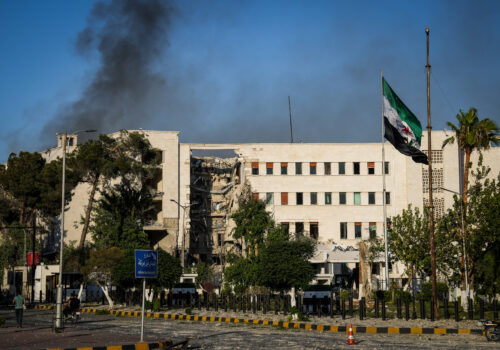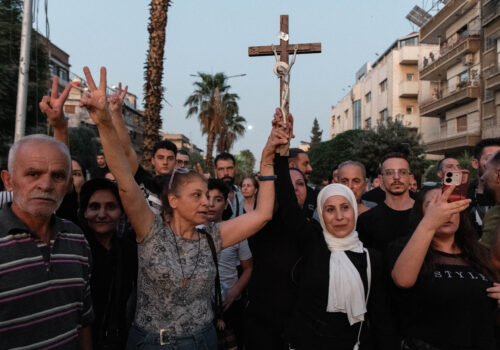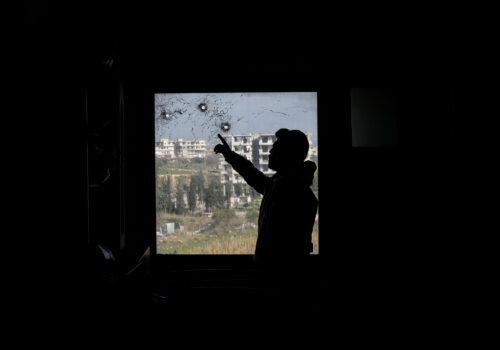Why the violence in my hometown, Swaida, goes beyond ‘rivalry.’
I recently returned from a mission to Syria, going between Swaida, my birthplace, and the capital city, Damascus. When I left on June 22, I could not have known that I would never return to the Syria that I left just a month ago. Last week, I woke up to an outpouring of grief and disbelief from the Druze and Christian communities in Swaida, as sectarian violence ravaged my hometown, resulting in the killing of hundreds of people.
Reports poured in: friends and family killed in their homes, doctors shot en route to hospitals, neighborhoods shelled and looted. The attacking forces ravaged a house I considered my second home. The pain was unbearable, shattering my belief in a future Syria where citizens are safe and institutions know their limits. Fourteen years of agony, thought to have finally achieved a reprieve after the December ousting of Bashar al-Assad’s regime, surged back. I found myself asking again: Is Syria’s tragedy rooted in state violence or sectarian civil war? And how did this happen again after Assad’s fall?
US officials described the events as “a rivalry” between Druze and Bedouins. That simplification mirrored Damascus’s version: a state stepping in to contain intercommunal strife. But this framing strips the crisis of its historical and political context. The truth is, Swaida’s suffering stems from its peripheral status and long-standing marginalization.
A distinct and marginalized region
As a Druze-majority, marginal province, Swaida was chronically underdeveloped. Its autonomy grew after 2014, when locals refused to be conscripted to fight their own people. In 2018, Swaida suffered a devastating Islamic State of Iraq and al-Sham (ISIS) attack, which resulted in the community’s need for protection and armament, leading to the formation of many armed groups. In 2023, Swaida further distanced itself from Damascus, when Druze leader Sheikh al-Hajari endorsed a civic uprising calling for regime change from Assad, leading to his rise as a political figure addressed by US officials, overshadowing the other two Druze religious leaders, Sheikhs Jarbouh and Hennawi.
These dynamics fostered a distinct socio-political status for Swaida—outside of full Damascus control—with local armed groups, mainly directed at deterring extremists, and a political structure strongly influenced by al-Hajari in the absence of an alternative political process. But when Assad fell abruptly in late 2024 and Hayat Tahrir al-Sham (HTS), once labeled extremist over its ties to al-Qaeda, took control, the opposition and transitional authorities failed to offer a path to re-merge these two political structures. A rushed attempt at state-building led instead to exclusion, mistrust, and instability—especially for minorities like the Druze, who bore arms mainly to deter extreme Islamist groups like HTS.
SIGN UP FOR THIS WEEK IN THE MIDEAST NEWSLETTER
Ironically, Damascus under Assad had framed al-Hajari a traitor for alleged Israeli ties—a charge that persisted after the regime’s fall.
These allegations tap into the Druze community’s complex role in Israel. Tribal and familial ties among Druze across Syria, Lebanon, Israel, and Jordan remain strong, and these bonds were often activated by humanitarian or security threats during the fourteen years of war.
In 2023, Israeli deterrence helped shield Swaida from regime attacks. Now, under new leadership, Syria’s transitional government has echoed the same rhetoric used by the Assad regime to delegitimize Swaida’s resistance. Yet, no Israeli weapons or forces were found in Swaida—only leftover Syrian army arms.
Syria in transition, Swaida lagging behind
Rather than addressing grievances, the transitional government took a unilateral approach, sidelining all local elites, including Swaida’s leadership, and failing to include diverse voices. Al-Hajari’s calls for decentralization, secularism, and democratic representation clashed with the new authorities’ centralized, Islamist-tinged vision. These demands, however, were criticized by government supporters as they came from a religious leader who enjoys power in his community.
The popular slogan among government supporters—“those who liberated decide”—alienated communities like Swaida, validating al-Hajari’s position. Fearing aggression, al-Hajari used international protection as a deterrent against Assad’s aggression in 2023. Those inside Swaida who favored engagement with Damascus had a marginal political weight, which made them shy away from confrontation, fearing community fragmentation, a survival instinct for minorities. Tensions deepened between Druze factions.
Coast massacres and sectarian tensions
The early transition saw massacres of Alawites on the coast, reportedly incited by members of the Transitional Government. These atrocities confirmed minority fears and validated al-Hajari’s warnings. While some factions were criticized for agreeing to join state institutions, al-Hajari’s resistance to disarmament gained traction.
In April 2025, a fabricated audio clip of a Druze Sheikh insulting Prophet Muhammad triggered protests and chants appearing to endorse ethnic cleansing, if not genocide.. Attacks followed against Druze in Jaramana and other areas. Later, an Israeli airstrike halted a regime offensive near Sehnaya, where extremist groups had targeted Druze civilians.
A Bedouin ambush against a Druze convoy of fighters to rescue the Druze in Sehnaya, with massive mobilization of Bedouins from different fronts, escalated the violence. Given the overwhelming numbers, al-Hajari called for international protection, which some saw as a plea for Israeli intervention. Meanwhile, negotiations with Damascus yielded an agreement on joint security; however, this agreement rapidly collapsed when state media framed the talks as a government win, prompting al-Hajari’s withdrawal.
The Bedouin-Druze flashpoint
Bedouins and Druze have coexisted in Swaida since the 1800s—at times in peace, at times in conflict. Most clashes stem from pastoralist-agrarian tensions. But in Swaida, these often evolved into sectarian strife, easily weaponized for mobilization.
Frequently, if armed clashes between Druze and Bedouins erupted inside Swaida, the Bedouins would retaliate outside Swaida, targeting Druze vehicles and blocking roads to Damascus—a critical lifeline for Swaida. These tactics were used by the Ottomans, the Assad regime, and now they are occurring again under the new government. Similarly, when Druze are attacked in clashes outside Swaida, the Druze often retaliate against Bedouins inside Swaida.
On July 13th, a Bedouin group kidnapped a man and took his car. In retaliation, an armed group linked to the owner detained Bedouins in Swaida’s suburbs. The situation escalated: retaliatory kidnappings, property seizures, then shelling from Bedouin groups, which killed eight people, including a child. Druze fighters mobilized. Mediation led to the release of the hostages by July 14.
Despite that resolution, on July 15, the ministries of interior and defense announced plans to forcibly enter Swaida to “restore peace.” Many interpreted this as a signal of Israeli approval, believing the Syrian government would not risk a direct retaliatory strike by Israel otherwise. The government’s offensive began from Daraa, targeting western Swaida. Resistance followed—not only from al-Hajari’s groups but also from Rejal El Karama, who supported integration with the state but were not consulted and opposed the incursion.
A video showing Druze fighters humiliating government forces—including handcuffing and verbally abusing them—prompted further army mobilization. Later videos appeared to show the government forces being executed. The incident intensified the government fighters’ resolve, and the Druze’s basic defenses were quickly overrun. Government forces entered al-Mazra’a, a key village, without resistance. Still, reports of looting and burning houses emerged.
As the offensive pushed forward, shelling hit residential areas, with reports of significant casualties and destruction of properties. To minimize casualties, identical statements from al-Hajari and Jarbouh welcomed state forces; however, violence continued. Videos surfaced showing fighters without uniforms, foreign accents, homes ablaze, and the public humiliation of elderly civilians. Al-Hajari said the government coerced him into the statement to prevent further bloodshed, but after continued attacks, he called for mass mobilization.
Numerous Facebook videos showed killings, looting, and shelling. Druze ambushes intensified, and al-Hajari again called for international protection. Israeli airstrikes soon followed, targeting heavy weaponry and demanding a full army withdrawal. The violence triggered a broader popular uprising beyond organized armed groups, forcing many regime forces to retreat.
On July 16, Damascus launched a massive counteroffensive with drones, shelling, and heavy troop deployments. Reports poured in of families slaughtered, homes looted, and neighborhoods devastated. Israeli strikes then hit Swaida and Damascus, including the defense ministry and presidential palace.
Damascus sought an exit and secured a deal with Jarbouh, recognizing the state while preserving local forces. However, al-Hajari refused the terms. That night, President Ahmed al-Sharaa gave a speech characterizing the events as a domestic issue, blaming Israel, and announced a withdrawal of government forces from the region, delegating security to local actors.
The possibility of unleashing civil war
After the withdrawal of government forces last week, Druze Facebook feeds poured with videos and pictures of mass atrocities, including field executions, mass slaughter of families, live decapitations, forcing people to jump from balconies, torturing, looting, and destruction of properties. Social media became a wildfire of videos showing sectarian killings that were used to construct an extremely distorted media narrative, reducing the events to Druze killing and kidnapping Bedouins. A social media campaign dehumanizing the Druze provided a pretext for genocide. The magnitude of savagery sent shocks in the community, instigating limited but serious calls for revenge.
One discussion I had with a key source in Shahba indicated that, driven by these horrors, retaliatory atrocities against a Bedouin community in Shahba included mass killing and looting. Local Shahba armed groups responded by protecting about one thousand women and children in their homes from the threat of break-ins, looting, and violence. The women and children were then moved to a local mosque that was making arrangements for their safe release from the territory.
Mass mobilization of tribal communities across Syria yielded tens of thousands in subsequent waves. Hundreds of civilians died in each wave. Video, filmed by the attackers in the past days, showed more brutal decapitations. Syrian towns along the way supported the attackers to kill Druze using an Islamic doctrine “that whoever equipped an attacker, as if he attacked, himself.”
Hundreds of college students in Aleppo received life threats. Demonstrations by Syrian students to expel Druze students emerged from universities. Druze boycott campaigns erupted, resulting in a cut in food supplies. A universal power outage and interrupted fuel paralyzed the town. Electricity-dependent water was stopped. Despite the US-backed cease-fire, Bedouin attacks continued, burning villages, with field reports indicating the destruction of infrastructure. Field reports from key sources indicate that more than twenty villages were burned, with no information made available by Syrian authorities on the status of their residents. A mediator of ongoing negotiations indicated that ninety-seven Druze women are missing, which delayed the release of the Bedouin community in Shahba. The fighting and killing continue.
The future is dark
The Swaida debacle is a political struggle to force an exclusive regime on a community that doesn’t trust it. Instead of trust building, hate speech was a policy, and ethnic cleansing is the outcome. The Druze-Bedouin conflict was not the cause, but a tool, and the outcome is a Sunni-Druze civil war.
When speaking to many locals of Swaida, Druze, and Christians in the diaspora, a common narrative persists: “How did we trust these people before?” There is complete mistrust in, and grievances against, the facade of state forces. The obstructed roads to Swaida and severed relationship to the hostile surrounding leave no choice but to have a humanitarian cross-border relationship with Jordan. The vision of a centralized, unified state is now considered delusional by many.
As someone who has been working on local governance models, I struggle to imagine any viable long-term solution. For now, an isolated, aid-dependent canton seems to be the only interim path, waiting for violence to stop and the new realities to shape the final outcomes.
Majd AlGhatrif is an Associate Professor and Director of the Syria Peace Project at Johns Hopkins University. He serves as a governance and health systems consultant to the Swiss government and the European Union, advising on the restructuring of the health sector in Syria. He is also a board member and the Founding President of the Swaida American Society.
Further reading
Wed, Jul 16, 2025
Five questions (and expert answers) about Israel’s strikes against Syria
New Atlanticist By
Our Middle East experts explain the roots of the crisis and what it means for Syria, Israel, the Druze, and the broader region.
Thu, Jun 26, 2025
Dispatch from Damascus: Church attack shows transition’s fragility
MENASource By Ibrahim Al-Assil
The bombing at Mar Elias Church is more than an isolated tragedy. It is a signal that Syria’s transition remains vulnerable to sabotage.
Wed, May 28, 2025
Sectarianism, social media, and Syria’s information blackhole
MENASource By
Since Assad’s December ousting, Syrians have struggled to sift the truth from fake claims about security incidents across the country.
Image: A person, injured in recent clashes in Syria's Sweida province, is transported as casualties receive treatment at a field medical point, following renewed fighting between Bedouin fighters and Druze gunmen, despite an announced truce, in Deraa, Syria July 18, 2025. REUTERS/Khalil Ashawi



